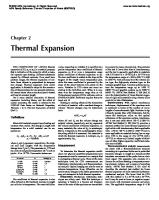Bktk II Thermal Properties Sifat Sifat Termal
26/09/2016 HEAT CAPACITY Lukhi mulia s Definition of heat capacity—ratio of energy change (energy gained or lost)
Views 74 Downloads 0 File size 695KB
Recommend stories
- Author / Uploaded
- Musthofa Asshidiqi Yahya
Citation preview
26/09/2016
HEAT CAPACITY Lukhi mulia s
Definition of heat capacity—ratio of energy change (energy gained or lost) and the resulting temperature change the heat capacity C is expressed as follows:
C = (J/mol-K, or cal/mol-K).
specific heat Specific heat (often denoted by a lowercase c) represents the heat capacity per unit mass and has various units (J/kg-K, cal/g-K, Btu/lbm-°F)
𝐶𝑉
• the heat capacity while maintaining the specimen volume constant
𝐶𝑃
• the other is for constant external pressure
1
26/09/2016
THERMAL EXPANSION
Temperature Dependence of the Heat Capacity
At low temperatures the relationship between 𝐶𝑣 and the absolute temperature T is 𝐶𝑣 = 𝐴𝑇 3
Figure 19.2 The temperature dependence of the heat capacity at constant volume;
.
Most solid materials expand upon heating and contract when cooled. The change in length with temperature for a solid material may be expressed as follows:
lf = final length l0 = initial length T0 = initial temperature Tf = final temperature 𝛼𝑙 = linear coefficient of thermal expansion (1/C° atau 1/F°)
θD is the Debye temperature
For thermal expansion, dependence of fractional volume change on the volume coefficient of thermal expansion and the temperature change.
𝛼𝑣 = volume coefficient of thermal expansion (1/C° atau 1/F°) ∆V = the volume change V0 = the original volume
2
26/09/2016
THERMAL CONDUCTIVITY
thermal conductivity is the property that characterizes the ability of a material to transfer heat
q = the heat flux or heat flow (W/m2, Btu/ft2-h) k = the thermal conductivity (W/m-K, Btu/ft-h-°F)
𝑑𝑇
= the temperature gradient through the conducting medium 𝑑𝑥
Mechanisms of Heat Conduction
k = 𝑘𝑙 + 𝑘𝑒 Metals Weidemann-Franz law—for metals, the ratio of thermal conductivity and the product of the electrical conductivity and temperature should be a constant
𝜎 = the electrical conductivity T = the absolute temperature L = a constant (The theoretical value of L , 2.44 x 10-8 Ω-W/(K)2)
Figure 19.4 Thermal conductivity versus composition for copper–zinc alloys. [Adapted from Metals Handbook: Properties and Selection: Nonferrous Alloys and Pure Metals, Vol. 2, 9th edition, H. Baker (Managing Editor), American Society for Metals, 1979, p. 315.]
3
26/09/2016
Ceramics
Figure 19.5 Dependence of thermal conductivity on temperature for several ceramic materials. (Adapted from W. D. Kingery, H. K. Bowen, and D. R. Uhlmann, Introduction to Ceramics, 2nd edition. Copyright 1976 by John Wiley & Sons, New York. Reprinted by permission of John Wiley & Sons, Inc.)
QUESTIONS AND PROBLEMS
1. Estimate the energy required to raise the temperature of 5 kg (11.0 lbm) of the following materials from 20 to 150°C (68 to 300°F): aluminum, brass, aluminum oxide (alumina), and polypropylene. 2. For copper, the heat capacity at constant volume Cv at 20 K is 0.38 J/mol-K, and the Debye temperature is 340 K. Estimate the specific heat (a) at 40 K and (b) at 400 K. 3. A copper wire 15 m (49.2 ft) long is cooled from 40 to -9°C (104 to 15°F). How much change in length will it experience?
4




![[Makalah SKI PBI Group 4] Karakteristik Dan Sifat Pemimpin Islam](https://vsip.info/img/200x200/makalah-ski-pbi-group-4-karakteristik-dan-sifat-pemimpin-islam-pdf-free.jpg)




